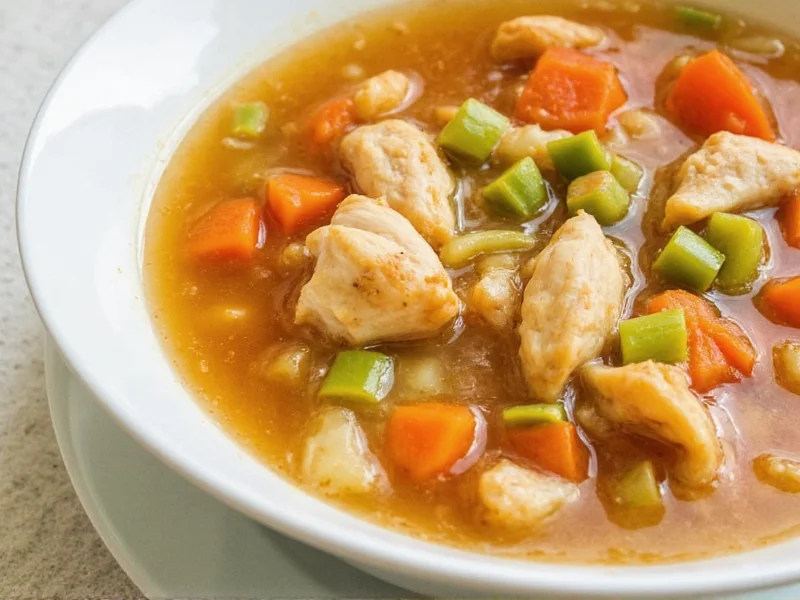Slow cooking transforms simple ingredients into a comforting masterpiece. Crockpot chicken vegetable soup represents the pinnacle of set-it-and-forget-it cooking, delivering deep flavors with minimal effort. Unlike rushed stovetop methods, the slow cooker's gentle heat extracts maximum flavor from bones and vegetables while keeping chicken remarkably tender.
Why Slow Cooking Excels for Chicken Vegetable Soup
The magic of crockpot chicken vegetable soup lies in its gradual flavor development. As ingredients simmer for hours, collagen from chicken bones breaks down into gelatin, creating that signature rich mouthfeel professional chefs prize. Vegetables release their natural sugars slowly, building complexity without becoming mushy. This easy crockpot chicken vegetable soup recipe requires just 15 minutes of prep for hours of hands-off cooking.
Essential Ingredients Breakdown
Quality ingredients make the difference between ordinary and extraordinary soup. Don't substitute haphazardly when preparing your homemade crockpot chicken vegetable soup.
| Ingredient | Why It Matters | Pro Tip |
|---|---|---|
| Bone-in chicken thighs | Superior flavor and moisture retention | Brown first for deeper flavor (optional but recommended) |
| Yellow onions | Sweet base flavor without overpowering | Leave skin on for richer color |
| Fresh thyme | Earthy notes that mellow beautifully | Use whole sprigs for easy removal |
| Carrots & celery | Classic mirepoix foundation | Cut uniformly for even cooking |
| Low-sodium broth | Control over final salt level | Homemade yields best results |
Step-by-Step Preparation Guide
Follow these steps for foolproof crockpot chicken soup for meal prep that tastes like it simmered all day:
- Layer ingredients strategically - Place hard vegetables (carrots, potatoes) at bottom, then chicken, then softer vegetables (zucchini, peas). This ensures even cooking.
- Add liquid carefully - Pour broth around edges rather than over chicken to prevent herb wash-off.
- Cook uncovered for first 30 minutes on high to develop flavors, then cover for remainder of cooking time.
- Remove chicken at 3 hours (high) or 6 hours (low), shred, then return to pot to prevent overcooking.
- Add delicate vegetables like spinach or peas during last 30 minutes to maintain texture.
Avoid These Common Crockpot Soup Mistakes
Even experienced cooks make these errors when preparing healthy crockpot chicken soup with vegetables:
- Overfilling the slow cooker - Never fill beyond ⅔ capacity to allow proper heat circulation
- Adding all vegetables at once - Root vegetables need longer than leafy greens
- Using boneless chicken breasts - They dry out during long cooking; thighs maintain moisture
- Seasoning too early - Salt concentrates as liquid reduces; adjust at end
- Skipping the deglaze step - If browning chicken first, scrape fond into slow cooker
Customizations for Dietary Needs
This gluten-free crockpot chicken vegetable soup easily adapts to various requirements:
- Keto version: Omit potatoes, add extra celery and radishes for crunch
- Vegan adaptation: Use vegetable broth and omit chicken (cook mushrooms separately)
- Low-sodium option: Double herbs and citrus zest to compensate for reduced salt
- Creamy texture without dairy: Blend ½ cup cooked white beans with 1 cup broth before adding
Storage and Reheating Perfection
Your freezer-friendly crockpot chicken vegetable soup improves with time. Follow these storage guidelines:
- Cool completely before storing (never put hot soup directly in fridge)
- Store in airtight containers with 1-inch headspace for expansion
- Refrigerate for up to 5 days or freeze for 3 months
- Reheat gently on stove (not microwave) to preserve texture
- Add fresh herbs after reheating for brightness
Maximizing Flavor in Every Batch
Professional chefs use these techniques for restaurant-quality crockpot chicken soup without cream of mushroom:
- Add an unpeeled onion studded with cloves for subtle spice notes
- Include a Parmesan rind for umami depth (remove before serving)
- Finish with lemon juice or apple cider vinegar to brighten flavors
- Use 10% less liquid than stovetop recipes (slow cookers lose less moisture)
- Let soup rest 20 minutes after cooking before serving for flavor integration
Frequently Asked Questions
How long should chicken cook in crockpot for soup?
Bone-in chicken pieces need 6-8 hours on low or 3-4 hours on high. Remove chicken when internal temperature reaches 165°F (74°C), shred, then return to pot. Boneless pieces require 2-3 hours on low to prevent drying out.
Can I put raw chicken directly in crockpot for soup?
Yes, you can add raw chicken directly to the crockpot. However, browning chicken first in a skillet creates richer flavor through the Maillard reaction. If short on time, raw chicken works fine but yields a milder broth.
Why is my crockpot chicken soup watery?
Slow cooker soups sometimes appear watery because they don't reduce like stovetop versions. Remove lid during last 30-60 minutes of cooking to allow evaporation. Alternatively, mix 1 tbsp cornstarch with 2 tbsp cold water and stir in during final 20 minutes to thicken.
What vegetables hold up best in slow cooker soup?
Root vegetables like carrots, parsnips, and turnips maintain texture throughout cooking. Add softer vegetables like zucchini, peas, and spinach during the last 30-60 minutes. Potatoes work well but can become mushy if cut too small or cooked too long.
How do I fix bland crockpot chicken soup?
Revive bland soup with acid (lemon juice or vinegar), umami boosters (soy sauce or tomato paste), or aromatic enhancements (fresh herbs or garlic). Always adjust seasoning at the end of cooking when flavors have concentrated. A splash of Worcestershire sauce often works wonders.











 浙公网安备
33010002000092号
浙公网安备
33010002000092号 浙B2-20120091-4
浙B2-20120091-4